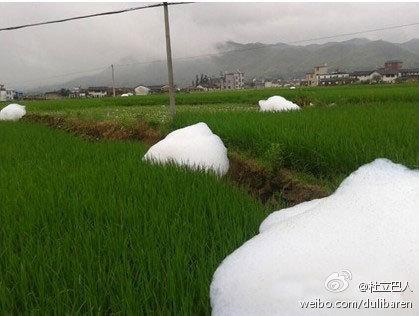Rice paddies are expected to be lush and fruitful after a thunderstorm, but a paddy in Dabu Village in southeastern China’s Fujian Province unexpectedly grew white shapes that have been described as like “cotton candy” or “monsters.”
Local farmers are perplexed: “I’ve lived in this village for over 60 years and have never seen large white bubbles growing in the fields,” one told the Straits Herald.
Another local said, “It looks very scary! These huge bubbles grow in the fields and have a variety of shapes; some look like frogs and others like livestock.”
The first posting of photos of these “monsters” was on May 22 and attracted much comment.
Mr. Huang, the photographer, said that his photos were shot around 8 am when the weather was overcast.
The bubbles quickly started to expand and reached heights well over six feet.
Not only did they grow larger, but they multiplied: “At the beginning, there were not that many but after an hour, more of these cotton-candy shapes appeared,” Huang said.
Huang used a bamboo rod to poke one and found that it was quite sticky but odorless.
The shapes hung around as long as it was cloudy but gradually vanished with the afternoon sun.
From where could these large bubbles originate?
The villagers said that they do not use laundry detergents or dishwashing liquid. And a search of the area resulted in no further clues.
A Straits Herald reporter researched the phenomenon and found that similar “monsters” had appeared in 2008 in a village seven hours’ drive away.
China’s largest social media, Weibo, has seen much discussion.
“I used to see small bubbles when I was a kid,” posted one individual. “They were all over the fields and the river banks. But I’ve never seen monsters like these!”
Another poster wrote: “With all the river pollution, it’s no surprise that these giant bubbles would appear.”
There is a more prosaic and scientific explanation: methane. The gas results from the decomposition of fertilizer and decaying organic matter used to increase crop yields. Because it is considered a greenhouse gas, scientists have been monitoring the problem, which is not expected to lessen anytime soon due to the need for more food to feed the burgeoning populations in developing countries like China.
Translated by Aileen Wu. Written in English by Gary Pansey.
